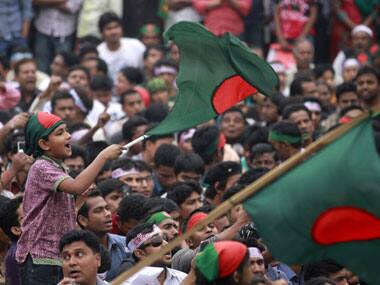“To find traitors, the whole village has been destroyed”, wrote the journalist Serajuddin Hossain in September, 1971, as Pakistani troops began their genocidal campaign in East Bengal’s countryside. Less than a week later, a group of armed men stormed into his rented home Dhaka. Later, after Indian troops liberated the city, his son visited the mass graves in which the bodies of East Bengal’s intellectuals had been dumped. He saw the bodies of the journalist Selina Parvin and the eminent cardiologist Fazl-e Rabbee. Hossain’s body was never found. Early on Wednesday, Bangladesh’s 1971 war crimes tribunal sentenced top Jama’at-e-Islami leader Ali Ahsan Muhammad Mujahid to death, holding he commanded the Islamist killing squads which cut down the flower of the East Bengal intelligentsia. The judgment came just a day after Mujahid’s party colleague Ghulam Azam received a 90-year sentence for his role in the 1971 war crimes. Islamist mob violence is since reported to have claimed nine lives in 48 hours; members of the ruling Awami League, media, progressive political groups and Bangladesh’s Hindu minority have come under attack. [caption id=“attachment_965487” align=“alignleft” width=“380”]  The protests at Shahbag, Bangladesh. Reuters.[/caption] Because of the impact these events will have in India’s north-east and eastern states— West Bengal Islamists have been marching on the streets of Kolkata in support of their counterparts in Bangladesh — New Delhi ought be watching these developments with great care. Like earlier judgments, the Serajuddin Hossain case goes to the heart of Bangladesh’s troubled history. In March 1971, Pakistan had launched Operation Searchlight — a brutal crackdown on pro-independence forces, which claimed the lives of thousands. In July, 1971, India’s official war history records, Bangladesh guerrillas who fled the crackdown began operations which would eventually cost the Pakistan army 4,000 casualties in over 825 ambushes. Bangladesh’s nationalist intelligentsia were repelled by the Pakistan army’s savagery. Panicked at the power of their ideas, the army began a systematic campaign to eliminate them, using the Jama’at-linked militia al-Badr and al-Shams. “Al-Badr”, Mujahid wrote in the Jama’at newspaper Sangram in April, 1971, “is the angel of death”. From earlier judgments, we know Bangladesh’s countryside bore the burnt of the violence. In May, the tribunal convicted Jama’at leader Muhammad Kamaruzzaman for helping Pakistani troops rape and murder unarmed villagers. Hafiza Bewa, told the who lost her husband Ibrahim Bewa, her brother Abul Hossain, and her uncles Seraj Ali and Khejur Ali in one massacre, told the court she was beaten with a rifle and raped among the dead bodies — as Kamaruzzaman watched. Dhaka’ nationalist intelligentsia and students, too, suffered savage violence. In March that year, teachers at Dhaka university were butchered—among them, the philosopher Govinda Chandra Dev, the dramatist Munir Chowdhury, the mathematician Hobibur Rahman, the Sanskrit scholar, Sukhranjan Somaddar, the psychologist Mir Abdul Quaiyum. In December, another 200 intellectuals were swept up by al-Badr death squads, tortured and then executed. Chowdhury Moinuddin — charged before the war crimes tribunal with personally executing at least eighteen of these intellectuals — now lives in the United Kingdom, reportedly serving as a trustee of the charity Muslim Aid and consulting on faith issues with the National Health Service. From Mujahid’s story, we know this: the war criminals of 1971 were proved adroit at rehabilitating themselves within independent Bangladesh. In 1975, when Bangladesh’s generals executed the nation’s founding father, Sheikh Mujib-ur-Rahman, they turned to the Islamists for legitimacy. Mujahid contested the parliamentary election in 1986, 1991, 1996 and 2008, losing each time — but served as minister in the right-wing Bangladesh Nationalist Party-Jama’at alliance government from 2001-2006. His role as a mass killer was airbrushed out of history. December 14th was commemorated each year as a day of mourning for the intellectuals — but the men responsible grew ever more powerful. It wasn’t until Sheikh Hasina Wajed— Mujib-ur-Rahman’s daughter — took power in 2009 that the wheel began to turn again. Backed by Bangladesh’s Supreme Court, Sheikh Hasina’s Awami League restored the secular principles of Bangladesh’s 1972 constitution, and outlawed faith-based political parties. In February this year, secular youth groups in Bangladesh began the Shahbag protests, demanding capital punishment for 1971 war criminals. Like Hossain, the Shahbag protestors have been using words to fight Islamist violence, hoping to build a new country. Hefajat-o-Islam, a Jama’at affiliated organisation, has been leading a violent fightback, calling for blasphemy laws, gender segregation and an end to the prosecutions. The crisis has grown inexorably. Rajib Haider, one of the Shahbag bloggers, was murdered by Jamaat activists on February 15. Thirteen days later, 40 people were killed in clashes between Islamists and the ruling Awami League. Bangladesh is once again poised at a pivotal moment in history, just as it was in 1971. India’s intellectual élite and the government need to break their silence — and speak out in favour of the epic struggle against theocratic fascism unfolding in that country.
December 14th, the day over 200 East Bengal intellectuals were massacred by the Pakistan army, was commemorated each year as a day of mourning in Bangladesh—as the men who did the killing held power. Now, the dead have finally received some justice.
Advertisement
End of Article
Written by FP Archives
see more


)

)
)
)
)
)
)
)
)



